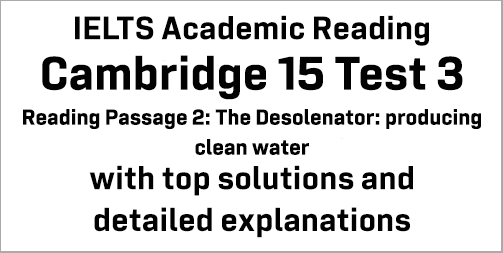IELTS Academic Reading: Cambridge 15 Test 3 Reading passage 2; The Desolenator: producing clean water; with best solutions and best explanations
This Academic IELTS Reading post focuses on solutions to IELTS Cambridge 15 Reading Test 3 Reading Passage 2 entitled ‘The Desolenator: producing clean water’. This is a targeted post for IELTS candidates who have big problems finding out and understanding Reading Answers in the AC module. This post can guide you the best to understand every Reading answer without much trouble. Finding out IELTS Reading answers is a steady process, and this post will assist you in this respect.
IELTS Cambridge 15 Test 3: AC Reading Module
Reading Passage 2: Questions 14-26
The title of the passage: The Desolenator: producing clean water
Questions 14-20: List of headings
[In this question type, IELTS candidates are provided with a list of headings, usually identified with lower-case Roman numerals (i, ii, iii, etc,). A heading will refer to the main idea of the paragraph or section of the text. Candidates must find out the equivalent heading to the correct paragraphs or sections, which are marked with alphabets A, B, C, and so forth. Candidates need to write the appropriate Roman numerals in the boxes on their answer sheets. There will always be two or three more headings than there are paragraphs or sections. So, some of the headings will not be used. It is also likely that some paragraphs or sections may not be included in the task. Generally, the first paragraph is an example paragraph that will be done for the candidates for their understanding of the task.
TIPS: Don’t read the list of headings first. Go straight to the question. Skimming is the best reading technique. You need not understand every word here. Just try to gather the gist of the sentences. That’s all. Read quickly and don’t stop until you finish each sentence.]
Question no. 14: Section A
We have to skim this section to find the answer to this question.
At the beginning of Section A, the writer says, “Travelling around Thailand in the 1990s, William Janssen was impressed with the basic rooftop solar heating systems that were on many homes, . . . .”
This part of the text suggests that Janssen got his initial inspiration from Thailand in the 1990s.
Then, in the last few lines of the section, the writer says, “ . . .. Two decades later Janssen developed that basic idea he saw in Southeast Asia into a portable device that uses the power from the sun to purify water.”
This part of the text suggests that Janssen was able to make a device (new product) to purify water from his inspiration earned in Thailand after twenty years.
So, the answer is: iii (From initial inspiration to new product)
Question no. 15: Section B
The answer lies in the very first lines of section B. The writer says here, “The Desolenator operates as a mobile desalination unit that can take water from different places, such as the sea, rivers, boreholes and rain, and purify it for human consumption. . . .”
Here, different places, such as the sea, rivers, boreholes and rain = a range of sources, purify = cleaning water,
So, the answer is: vi (Cleaning water from a range of sources)
Question no. 16: Section C
In section C, take a close look at lines 2-3, as the author of the text writes here, “ . .. Its main selling point is that unlike standard desalination techniques, it doesn’t require a generated power supply: just sunlight. . ..”
Here, unlike standard desalination techniques = What makes the device different from alternatives,
So, the answer is: v (What makes the device different from alternatives)
Question no. 17: Section D
The first lines of the section give us the answer. The writer says, “A recent analysis found that at least two-thirds of the world’s population lives with severe water scarcity for at least a month every year. . . .”
Here, at least two-thirds of the world’s population = the number of people, severe water scarcity = water shortages,
So, the answer is: x (The number of people affected by water shortages)
Question no. 18: Section E
Again, the first lines provide the answer to this question. In Section E, the writer says in the beginning, “The device is aimed at a wide variety of users – from homeowners in the developing world who do not have a constant supply of water to people living off grid in rural parts of the US. .. .. ..”
Here, a wide variety of users = The range of potential customers,
So, the answer is: iv (The range of potential customers for the device)
Question no. 19: Section F
In this section, the answer is found in the comment made by Janssen, as he describes the mission (primary goal) of the project. In lines 3-6, the author writes, as Janssen says, “ . .. . said Janssen, ‘We are a venture with a social mission. We are aware that the product we have envisioned is mainly finding application in the developing world and humanitarian sector and that this is way we will proceed. . . ..”
Here, a social mission = non-profit/voluntary/ charitable goal,
So, the answer is: viii (Profit not the primary goal)
Question no. 20: Section G
The second line of the text give the answer, as the writer says here, “ . .. .. It has raised £340,000 in funding so far. .. . ..”
Here, funding = finance,
So, the answer is: i (Getting the finance for production)
Questions 21-26: Summary completion
[In this kind of question candidates are given a summary for one, two, or three paragraphs with some fill in the blanks questions. Candidates need to find out the related paragraphs by correctly studying the keywords from the questions. Then, they should follow the steps of finding answers to fill in the gaps.]
The headline of the summary: How the Desolenator works
The headline indicates that all the answers can be found in section C.
Question no. 21: The energy required to operate the Desolenator comes from sunlight. The device can be used in different locations, as it has ________ .
Keywords for the question: energy, operate, the Desolenator, sunlight, device, can be used, different locations, as,
In section C, where the writer describes how this device works, let’s take a look at line no. 4, “ .. . It measures 120 cm by 90 cm, and is easy to transport, thanks to its two wheels. . . .”
Here, easy to transport = the device can be used in different locations,
So, the answer is: wheels
Question no. 22: Water is fed into a pipe, and a ________ of water flows over a solar panel.
Keywords for the question: water, fed into, pipe, flows over, solar panel,
In lines 5-6 of section C, the writer explains, “. . . Water enters through a pipe, and flows as a thin film, between a sheet of double glazing and the surface of a solar panel, where it is heated by the sun. .. ..”
Here, Water enters through a pipe = Water is fed into a pipe, the surface of a solar panel = over a solar panel,
So, the answer is: film
Question no. 23: The water then enters a boiler, where it turns into steam. Any particles in the water are caught in a ________.
Keywords for the question: boiler, turns into, steam, any particles, in, water, caught in,
In lines 6-9 of section C, the writer continues to explain, “. . . . The warm water flows into a small boiler (heated by a solar-powered battery) where it is converted to steam. When the steam cools, it becomes distilled water. The device has a very simple filter to trap particles, . .. .”
Here, The warm water flows into a small boiler = The water then enters a boiler, where it is converted to steam = where it turns into steam, trap = caught in,
So, the answer is: filter
Question no. 24: The purified water comes out through one tube, and all types of _______ come out through another.
Keywords for the question: purified water, comes out, through, one tube, all types of, come out, through, another,
The answer to this question can be found lines 9-11, “ . .. There are two tubes for liquid coming out: one for the waste – salt from seawater, fluoride, etc. – another for the distilled water. . ..”
Here, the distilled water = the purified water, and, salt from seawater, fluoride, etc = all types of waste,
So, the answer is: waste
Questions no. 25: A screen displays the ________ of the device, . . . .. .
Keywords for the question: screen, displays, of the device,
In lines 11-12, the author describes, “ . . .The performance of the unit is shown on an LCD screen . . …”
Here, an LCD screen = a screen, is shown = displays,
So, the answer is: performance
Questions no. 26: . .. . and transmits the information to the company so that they know when the Desolenator requires __________.
Keywords for the question: transmits, information, to the company, so that, know, when, the Desolenator, requires,
The last line of section C says, “ . . . and transmitted to the company which provides servicing when necessary.”
Here, transmitted to the company = transmits the information to the company, when necessary = when the Desolenator requires,
So, the answer is: servicing
Click here for solutions to Cambridge 15 Academic Test 3 Reading Passage 1
Click here for solutions to Cambridge 15 Academic Test 3 Reading Passage 3




3 thoughts on “IELTS Academic Reading: Cambridge 15 Test 3 Reading passage 2; The Desolenator: producing clean water; with best solutions and best explanations”